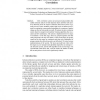Free Online Productivity Tools
i2Speak
i2Symbol
i2OCR
iTex2Img
iWeb2Print
iWeb2Shot
i2Type
iPdf2Split
iPdf2Merge
i2Bopomofo
i2Arabic
i2Style
i2Image
i2PDF
iLatex2Rtf
Sci2ools
AI
2008
Springer
2008
Springer
Using Unsupervised Learning for Network Alert Correlation
Alert correlation systems are post-processing modules that enable intrusion analysts to find important alerts and filter false positives efficiently from the output of Intrusion Detection Systems. Typically, however, these modules require high levels of human involvement in creating the system and/or maintaining it, as patterns of attacks change as often as from month to month. We present an alert correlation system based on unsupervised machine learning algorithms that is accurate and low maintenance. The system is implemented in two stages of correlation. At the first stage, alerts are grouped together such that each group forms one step of an attack. At the second stage, the groups created at the first stage are combined such that each combination of groups contains the alerts of precisely one full attack. We tested various implementations of the system. The most successful one relies in the first stage on a new unsupervised algorithm inspired by an existing novelty detection ...
| Added | 01 Jun 2010 |
| Updated | 01 Jun 2010 |
| Type | Conference |
| Year | 2008 |
| Where | AI |
| Authors | Reuben Smith, Nathalie Japkowicz, Maxwell Dondo, Peter Mason |
Comments (0)

